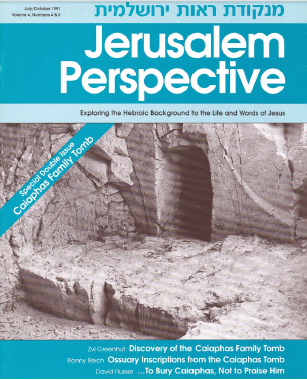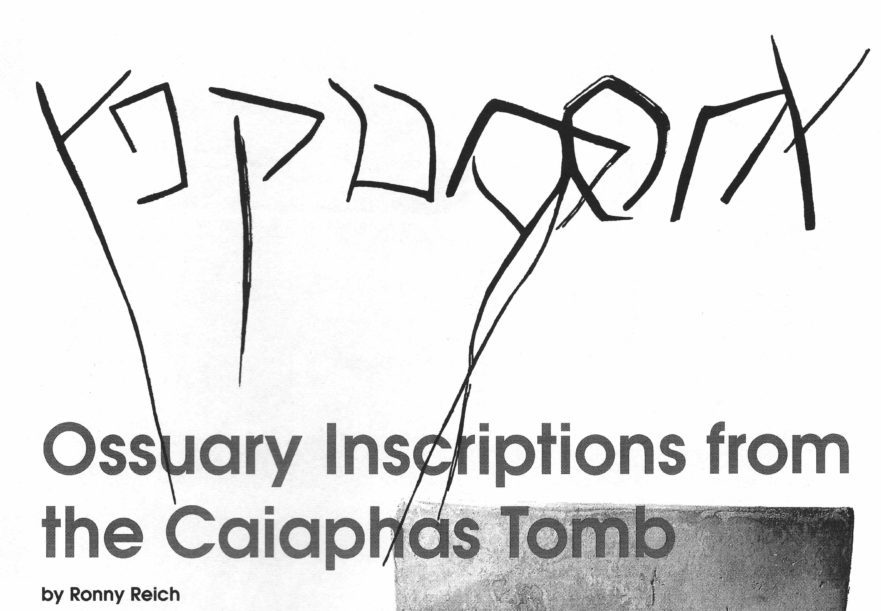How to cite this article: Ronny Reich, “Ossuary Inscriptions from the Caiaphas Tomb,” Jerusalem Perspective 33/34 (1991): 13-22 [https://www.jerusalemperspective.com/2598/].
The ossuaries Zvi Greenhut excavated from a burial cave in the south of Jerusalem bear several inscriptions.[17] These are actually graffiti in the cursive style of Jewish script typical of ossuary inscriptions, and were incised with a sharp implement, probably by the relatives of those who were being buried. The language of the inscriptions is Aramaic which, together with Hebrew and Greek, was one of the three languages used by Jews in the Second Temple period.
Some letters are clear, such as the ל (lamed), ק (kof) and ש (shin). Others are more difficult to read, such as the mem in its medial (מ) and final (ם) forms. One typical feature of cursive script is the use of ligatures, that is the connection of two adjacent letters into one combined sign.
To the Hebrew-reading layman, the form of א (alef) that appears in these inscriptions might seem strange. The letter is missing its left leg and looks like the final form of the tsadi (ץ). In fact it is one of the cursive forms of the alef in use in this period.[18]
These inscriptions are small in size and crudely drawn, and it is obvious that they were not meant for public display. Rather, the inscriptions were for the purpose of identifying the various family members buried in the tomb. Perhaps also it was believed that writing the deceased person’s name would keep it from being forgotten.
Premium Members and Friends of JP must be signed in to view this content.
If you are not a Premium Member or Friend, please consider registering. Prices start at $5/month if paid annually, with other options for monthly and quarterly and more: Sign Up For Premium

- [1] T. Ilan, “Notes on the Distribution of Jewish Women’s Names in Palestine in the Second Temple and Mishnaic Periods,” Journal of Jewish Studies, 40/2 (1989): 191-192. ↩
- [2] Ibid. ↩
- [3] T. Ilan, “Names of Hasmoneans in the Second Temple Period,” Eretz-Israel 19 (M. Avi-Yonah Volume, 1987): 238-241 (Hebrew with English summary on p. 79*). ↩
- [4] J. Naveh, “Nameless People,” Israel Exploration Journal 40 (1990): 108-123. ↩
- [5] Matt. 26:3, 57; Luke 3:2; John 11:49; 18:13, 14, 24, 28; Acts 4:6. ↩
- [6] Antiquities 18:35, 95. ↩
- [7] R. Brodi, “Caiaphas and Cantheras,” in D.R. Schwartz, Agrippa I: The Last King of Judaea (Jerusalem, 1987), Appendix 4, 203-208 (Hebrew); English translation (Tübingen, 1990), 190-195. ↩
- [8] B.-Z. Rosenfeld, “The Settlement of Two Families of High Priests during the Second Temple Period,” Historical-Geographical Studies in the Settlement of Eretz-Israel, vol. 2, eds. Y. Katz, Y. Ben-Arieh, Y. Kaniel (Jerusalem, 1991), 212-218 (Hebrew). Click here to read an English translation of this article—JP. ↩
- [9] Brodi, op. cit., 195. ↩
- [10] Rosenfeld, op. cit., 214. ↩
- [11] N. Avigad, Discovering Jerusalem (Jerusalem-Nashville, 1983), 129-131. Another inscription which might be relevant is בת קתרא (bat kat·RA’, daughter of Cathra), written in ink on a potsherd found at Masada (see Y. Yadin and J. Naveh, The Aramaic and Hebrew Ostraca and Jar Inscriptions: Masada I [Jerusalem, 1989], 22 n. 405). ↩
- [12] Babylonian Talmud, Pesahim 57a; Tosefta, Menahot 13:21. ↩
- [13] Stern, loc. cit. ↩
- [14] The name תדטיון appears in an inscription on an ossuary discovered on the Mount of Olives in Jerusalem (E.L. Sukenik, Tarbiz i, 4 [1929/30]: 139-142). ↩
- [15] S. Klein, לחקר השמות והכינויים, Leshonenu 1 (1929): 341. ↩
- [16] Stern, op. cit. ↩
- [17] See Zvi Greenhut, “Discovery of the Caiaphas Family Tomb.” ↩
- [18] N. Avigad, “The Palaeography of the Dead Sea Scrolls and Related Documents,” Scripta Hierosolymitana 4 (1965): 56-87, Cols. XXIII, XXV, XXXII. ↩



